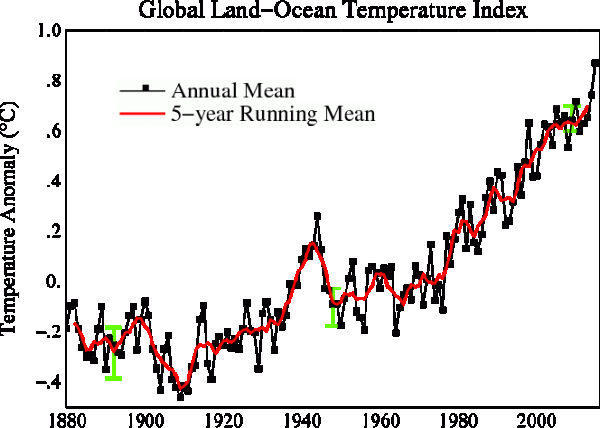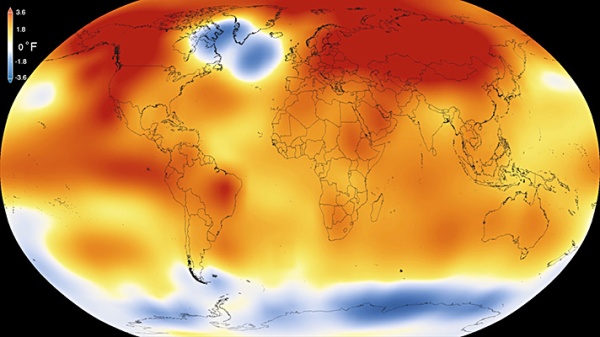Even
Radio New Zealand reported on this.
Last year was hottest on record globally - NASA
NASA, NOAA — 2015 Was Hottest Year on Record By a Significant Margin. 2016 May be Even Hotter.
“Even
without El Niño, this would have been the warmest year on record.”
Dr Gavin Schmidt, Director of NASA GISS, in a press conference today.
******
21
January, 2016
2015
was a historic year for global temperatures. A massive accumulation
of greenhouse gasses pushing above 400 parts per million CO2 (and
hitting in the range of 485 ppm CO2e) combined with one of the
strongest El Ninos on record to spike global temperatures in every
major climate monitor well beyond the 1 C above 1880s threshold. This
marks the first time in the history of human civilization that
temperatures have been so hot globally. A severe departure that moves
our current world decisively out of the Holocene context and into
hitherto uncharted territory.
(NASA
Land-Ocean Temperature Index shows a historic record hot year for
2015. A trend line that speaks volumes for how much human-forced
warming through fossil fuel burning has altered the world’s
climate. Image source: NASA
GISS.)
In
the NASA monitor,
2015 beat out previous record hot year 2014 by a significant 0.13 C
margin. A measure 0.87 C above the 1950-to-1981 NASA 20th Century
base-line and fully 1.09 C above 1880s averages. Just one look at the
graph above tells a stark story of raging global temperature
increases — especially since 1980 where the average decadal
increase is now solidly above 0.15 C every ten years.
NOAA’s
own monitor tells
a similar story with 2015 coming in at 0.90 C above the 20th Century
average or about 1.12 C above 1880s averages. That’s just 0.38 C
below the increasingly dangerous 1.5 C threshold and just 0.88 C
below the very dangerous 2 C mark. If the current rapid warming trend
in the global temperature graph were to merely continue, we’d pass
the 1.5 C mark in less than two decades time and hit the 2 C mark
within just 4-5 decades. That said, if
an analysis by Dr. Michael Mann is correct,
we could hit the 2 C mark by as early as the middle 2030s if we
continue fossil fuel burning at such a ridiculously rapid rate.
Most
Heat Concentrated Northward
Though
2015 was the hottest year on record, not all of that heat was evenly
distributed. Though practically all of the globe experienced above
average temperatures for the year, there were noted exceptions.
Greatest above average temperature departures concentrated in the
upper Latitudes of the Northern Hemisphere. Alaska, Western Canada,
the Beaufort Sea, the High Arctic north of Svalbard, the Barents and
Laptev Seas and most of Northern Continental Asia experienced extreme
temperature departures in the range of 3 to 3.6 degrees Celsius above
average. Exceptional heat in the range of 2-3 degrees Celsius above
average also held sway over the Western United States and an area of
warmth in the Northeastern Pacific dubbed the hot blob.
(2015
Showed a continued Northern Hemisphere Polar Amplification with
regions near and within the Arctic showing the greatest above average
temperature anomalies. Image source:NASA
GISS.)
Though
most of the world showed above average temperature readings, negative
departures appeared in the region of the Southern Ocean just north of
Antarctica and in the cool pool zone of the North Atlantic south of
Greenland. During recent years, atmosphere to ocean heat transfer has
been quite intense in the Southern Ocean — the upshot of
increasingly powerful storms in the 50s and 60s South Latitude
region. The North Atlantic cool pool has also been a persistent
feature during recent years — one that is likely related to a
weakening of the northward flow of the Gulf Stream, a
weakening of overturning circulation in the North Atlantic,
and an
increased rate of glacial melt outflow from Greenland (as
the current signal is stronger than traditional AMOC variability).
So, ironically, both cool pools remain as ever more clear indicators
that the global climate system is being driven out of balance by a
rampant human emission of fossil fuels.
2016
— Third Hottest Year in a Row?
Looking
ahead, it appears that 2016 may come in as yet one more hottest year
on record. An event that, should it occur, would mark the first time
in the global climate record that three back-to-back years set new
global atmospheric temperature records (2014, 2015, and 2016).
Heat
blowing off into the atmosphere from a record or near-record El Nino
still likely hasn’t had its full impact. So the first 4 months or
so of 2016 may see some very severe high temperature departures
similar to or even higher than what we saw in December (1.42 C above
1880s for JMA, 1.34 C above 1880s for NASA, and 1.33 C above 1880s
for NOAA). This probable early-year temperature spike for 2016 may be
enough to carry the year forward as the new record holder given the
fact that the current El Nino is expected to persist through late
spring or early summer. So a record warm 2016 has better than even
odds of occurring given the fact that the 2015-2016 El Nino was so
strong and since it may hold on well into 2016.
More
Warming in the Pipe
Longer
term, the rate of greenhouse gas accumulation in the Earth atmosphere
on the order of more than 2 parts per million CO2 each year and in
the range of 3 parts per million CO2e does not at all bode well. As
noted above, simply remaining on the current path of global
temperature increase brings the world above 2 C in just 4-5 decades
even as risks increase, given current levels of emissions, that the
world could see 2 C worth of warming by the mid 2030s. And since
greenhouse gasses are the driver in total of the current rampant
global temperature increase, we should be very clear that rapid cuts
to zero to net negative carbon emissions are necessary for the
protection of human civilizations and for the protection of the
life-sustaining capacity of the Earth itself.
Links:






No comments:
Post a Comment
Note: only a member of this blog may post a comment.